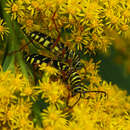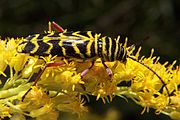en
names in breadcrumbs


Megacyllene robiniae, commonly known as the locust borer, is a species of longhorn beetle endemic to eastern North America. It is a serious pest of Robinia pseudoacacia, the black locust tree, with which it is sympatric.
The specific name, robiniae, is derived from the name Robinia, which is the generic name of the black locust tree, Robinia pseudoacacia, on which the larvae feed. The name Robinia was coined by Linnaeus to honor the royal French gardeners Jean Robin (father) and Vespasien Robin (son).
From a distance, M. robiniae can easily be mistaken for a wasp or bee, due to its black and yellow striped pattern. It can also be mistaken for two closely related species: M. caryae and M. decora. The adult beetle can be 11 to 28 mm (0.43 to 1.10 in) long, and it has a W-shaped third stripe on the elytra. The antennae of both sexes are dark brown to black. The male's antennae are two-thirds its body length, and the female's are one-half. The legs are reddish brown. The full grown larvae are legless, white, and robust, growing to roughly 25 mm (0.98 in) long.
Because there has been increasing use of R. pseudoacacia as an ornamental tree, the range of M. robiniae has expanded along with that of the tree. It is, however, still confined to North America and has not been recorded on any other continent where black locust has been introduced.
The beetle can be found almost anywhere that unprotected black locust trees grow, and the beetle is often more abundant when Solidago, commonly called goldenrod, is also present. Adults feed on the pollen of goldenrod. [1] Because of the adults' floral preferences, they tend to stay in uncultivated fields and meadows.

The females are often found running up and down black locust trunks in search of wounds in which to lay their eggs in the fall. Both sexes are most common from late day to dusk. Adults feed on pollen of goldenrods of the genus Solidago. They lay eggs in crevices and near wounds of the locust tree. The eggs hatch and the larvae spend the winter hibernating within the bark. Once winter ends, the larvae burrow into the tree trunk and start to tunnel. These tunnels are around 10 cm (3.9 in) long by 7 mm (0.28 in) wide, and serve as a primary infection site for wind-borne spores of the fungus Phellinus robiniae, which causes a damaging heart rot disease of Robinia species, causing them to be more susceptible to wind damage. The larvae overwinter within the tree and then pupate in late July and early August, and adults start to emerge in late August and throughout September. Adults are generally active from August through October. [2]
In 1900, due to attack by M. robiniae, the value of Robinia pseudoacacia was reported to be practically destroyed in nearly all parts of the United States beyond the mountain forests which are its home. Were it not for these beetles and their larval tunnels promoting fungal infections, it could be one of the most valuable timber trees that could be planted in the northern and middle states; young trees grow quickly and vigorously for a number of years, but soon become stunted and diseased, and rarely live long enough to attain any commercial value.[3] Currently, only one registered product, carbaryl, is effective against M. robiniae. It is applied in a single dose when adults are most active (August/September).[4]
Megacyllene robiniae, commonly known as the locust borer, is a species of longhorn beetle endemic to eastern North America. It is a serious pest of Robinia pseudoacacia, the black locust tree, with which it is sympatric.
La robinia borulo (Megacyllene robiniae) estas grava damaĝa insekto por ŝajnakacia robinio en Nordameriko. La nomo estas derivita de la plantogenra nomo robinio, malprofite al kiu la larvoj nutriĝas.
Ekde distanco oni facile konfuzas ĝin kun vespo aŭ abelo, eĉ ĉe pli proksima rigardo ĝi ofte ŝajne estas Megacyllene caryae aŭ M. decora . La plenkreska skarabo longas inter 12 kaj 20 mm kaj havas W-forman trian strion sur sia elitro. La antenoj de ambaŭ seksoj estas malhelbrunaj dum la anteno de la maskloj estas du trionoj de la korpolongo kaj por la femalo estas duono. Iliaj kruroj estas ruĝet-brunaj.
La arealo de tiu nearktisa insekto pligrandiĝis tra la jaroj ĉar ĝi sekvis la disvastiĝon de ŝajnakacia robinio. Ĉar pli kaj pli da homoj utiligas robinion kiel ornaman arbon la arealo de la robinia borulo kreskis. La arealo pligrandiĝis tra la jaroj ĉar ĝi sekvis la disvastigon de la ŝajnakacia robinio. Ĉar pli kaj pli da homoj utiligas robinion kiel ornaman arbon la arealo de la robinia borulo kreskis. Ili troviĝas preskaŭ ie ajn kie iu senprotekta ŝajnakacia robinio vegetas, ofte pli abunde kun ĉeesto de solidago. La femaloj ofte estas kurantaj supren kaj suben laŭlonge de robinio-trunkoj en serĉo por vundoj por enmeti siajn ovojn. Ambaŭ seksoj estas plej oftaj de malfrua tago ĝis krepusko. La imaginoj primare nutriĝas, pro tio ili emas resti en nekultivataj kampoj kaj herbejoj.
La imaginoj aŭtune metas siajn ovojn sur la arboj, poste la larvoj elkoviĝas kaj pasigas la vintron travintrante ene de la arboŝelo. Poste la larvoj tunelas la arbotrunkon. Tiuj tuneloj longas ĉirkaŭ 10 cm kaj larĝas 0,6 cm. La larvoj tiam pupiĝas en malfrua julio kaj frua aŭgusto; la imaginoj ekaperas en malfrua aŭgusto kaj tra septembro. Ili nutriĝas per solidagopoleno, la larvoj per la ligno de la ŝajnakacia robinio.
Ekzistas nuntempe nur unu registrita insekticido, kiu estas karbarilo (1-naftil-metilkarbamato). Ĝi estas uzata en ununura dozo kiam la plenkreskuloj estas plej aktivaj (aŭgusto/septembro) [1].
La robinia borulo (Megacyllene robiniae) estas grava damaĝa insekto por ŝajnakacia robinio en Nordameriko. La nomo estas derivita de la plantogenra nomo robinio, malprofite al kiu la larvoj nutriĝas.
Megacyllene robiniae
Le Cyllène du robinier (Megacyllene robiniae), en anglais Locust borer, présent dans maintes régions de l'Amérique du Nord, est une espèce d'insectes coléoptères de la famille des cérambycidés, qui vit dans les champs, les terres incultes et les prés, surtout où poussent le Robinier faux-acacia, une Fabaceae, et la Verge d'or, une Asteraceae. Il peut atteindre 20 à 28 mm de long.
Sa livrée est vespiforme, à pattes orange et antennes marron. Sa tête est conique, noire, le front et le clypeus maculés de jaune. Ses yeux noirs sont maculés de jaune près de la base antennaire, et cintrés de jaune. Son pronotum est cintré de quatre bandes transversales jaunâtres. Ses élytres fermés forment une longue ogive aplatie. Ils sont ornés de sept fines bandes jaunes, dont la 3e bande forme un « W ». Son pronotum et ses élytres sont couverts de fins poils jaunes.
En Amérique du Nord, il se rencontre du Nouveau-Brunswick jusqu'en Oregon, et de la Géorgie jusqu'au Texas.
La femelle est souvent observée parcourant le tronc du robinier, vraisemblablement à la recherche d'un endroit pour y pondre ses œufs, notamment dans une crevasse de l'écorce ou dans une plaie de l'arbre.
Sa larve est blanche, robuste, dépourvue de pattes et atteint environ 25 mm de long. Peu de temps après son éclosion, elle creuse des galeries dans le tronc et les branches des arbres, tant et si bien que son hôte est susceptible de se briser net par fort vent. Les arbres plantés dans des sites pauvres ou mal entretenus sont particulièrement vulnérables. La larve atteint la maturité vers la mi-juillet.
L'adulte se nourrit de la Verge d'or tôt le matin. À l'approche du crépuscule, il transite vers les arbres.
Lors de la saison des amours, les mâles se confrontent avec une grande agressivité l'un envers l'autre. Ils peuvent employer 7 tactiques pour déloger leur adversaire, même pendant l'accouplement, notamment en le martelant de coups avec leurs antennes ou de leurs pattes, en le mordillant de leurs mandibules, en immisçant sa tête entre le couple, ou en tirant et en traînant le couple afin de les séparer.
Le Cyllène du caryer (Megacyllene caryae) se distingue à son scutellum orné d'un chevron (tache en forme de V), flanquée d'un trait de chaque côté.
Megacyllene robiniae
Le Cyllène du robinier (Megacyllene robiniae), en anglais Locust borer, présent dans maintes régions de l'Amérique du Nord, est une espèce d'insectes coléoptères de la famille des cérambycidés, qui vit dans les champs, les terres incultes et les prés, surtout où poussent le Robinier faux-acacia, une Fabaceae, et la Verge d'or, une Asteraceae. Il peut atteindre 20 à 28 mm de long.
Megacyllene robiniae adalah spesies kumbang tanduk panjang yang tergolong famili Cerambycidae. Spesies ini juga merupakan bagian dari genus Megacyllene, ordo Coleoptera, kelas Insecta, filum Arthropoda, dan kingdom Animalia.
Larva kumbang ini biasanya mengebor ke dalam kayu dan dapat menyebabkan kerusakan pada batang kayu hidup atau kayu yang telah ditebang.
Megacyllene robiniae adalah spesies kumbang tanduk panjang yang tergolong famili Cerambycidae. Spesies ini juga merupakan bagian dari genus Megacyllene, ordo Coleoptera, kelas Insecta, filum Arthropoda, dan kingdom Animalia.
Larva kumbang ini biasanya mengebor ke dalam kayu dan dapat menyebabkan kerusakan pada batang kayu hidup atau kayu yang telah ditebang.
Megacyllene robiniae is een keversoort uit de familie van de boktorren (Cerambycidae). De wetenschappelijke naam van de soort werd voor het eerst geldig gepubliceerd in 1771 door Forster.[1]
Bronnen, noten en/of referentiesMegacyllene robiniae là một loài bọ cánh cứng trong họ Cerambycidae.[1]
Megacyllene robiniae là một loài bọ cánh cứng trong họ Cerambycidae.